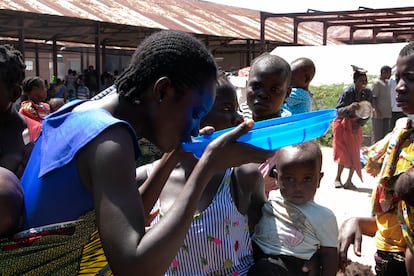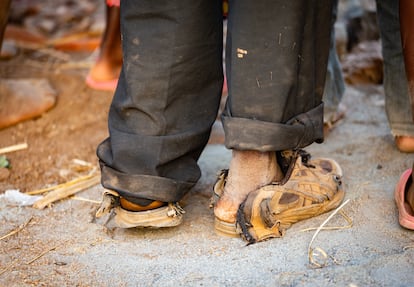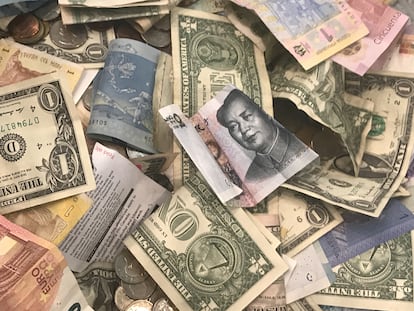Global South pays more to service its debt than it receives in development aid
In 2022, the first year of sharp rate hikes to curb rising inflation, the countries of the Global South paid almost $50 billion more in debt than they received in new financing, according to data from the UN’s trade and development arm

Crises, like successes, are seen through different eyes depending on who the passive subject is. And this is one of those silent shocks, a blind spot in the wide angle of the world economy. Far from the headlines, rising interest rates are taking their toll on emerging and developing countries: the Global South paid more on its debt last year in principal and interest repayments than it received in development aid and new loans. Inflows to this group of nations fell to their lowest level since the global financial crisis, according to figures from the NGO ONE Campaign. A warning sign that should give the Federal Reserve and the European Central Bank (ECB) pause for thought.
In 2022, the first year of sharp rate hikes to curb rising inflation, the countries of the Global South paid almost $50 billion more in debt than they received in new financing, according to data from the UN’s trade and development arm (UNCTAD). At the same time, official development assistance (ODA) fell for the second consecutive year and remained well below the target of 0.7% of gross national income (GNI). This target dates to the 1970s and, more than 50 years later, it has still not been met.
We are witnessing a worrying trend: financial flows are flowing out of the developing countries that need them most and towards their creditorsRebeca Grynspan, Secretary-General of the United Nations Conference on Trade and Development
“We are witnessing a worrying trend: financial flows are flowing out of the developing countries that need them most and towards their creditors,” summarizes the head of UNCTAD, Rebeca Grynspan, in statements to EL PAÍS. “These are nations that need external resources to complement their internal efforts and, without a positive trend in external financing, their capacity for growth is severely limited.” The fiscal constraints imposed by this situation, she adds, make it almost impossible to achieve Sustainable Development Goals (SDGs): “Addressing the overlapping crises, such as the climate emergency, will be an unattainable challenge if these trends are not reversed.”
It is a reality also acknowledged by the International Monetary Fund (IMF) in its latest fiscal monitor: “Many low-income countries continue to experience significant shocks.” The lender of last resort also points to the strong dollar as a key factor behind the rise in the cost of their debts, which are largely denominated in that currency, as well as aid flows and financing from China, which have been “falling for several years.” The result: forced austerity with serious social consequences.

“It is said that there is no debt crisis in the sense that there is no crisis for creditors, for banks, which are better off than ever,” says Juan Carlos Moreno-Brid, a professor at the National Autonomous University of Mexico (UNAM) specializing in development economics. “But those who live in middle-income and, above all, low-income countries see only one reality: that of public investment, education and healthcare, which are clearly declining. It is a silent crisis, but it is a debt crisis after all.” A crisis, he says, “with the face of the poor and of the middle class in many emerging countries.”
Long ago, since the very beginning of globalization and big finance, decisions made in Washington and Frankfurt ceased to matter only within their sphere of influence. Today, that sphere is global: what is decided at the governing councils of the Fed and the ECB matters as much, or more, in Vilnius or Phoenix as in Nairobi or La Paz. “It is essential that the central banks of the rich countries start lowering rates soon,” says Moreno-Brid, as this will give emerging countries room to lower rates without the risk of capital flight. High rates, he adds, “exacerbate” the problem of credit restrictions for investment.
“The higher interest rates are hitting the emerging world more than the rest,” acknowledges Martín Castellano of the Institute of International Finance. “And, even more so, the poorest countries, which have been expelled from the capital market or, in the best of cases, have had to tolerate higher funding costs.”
Africa, in the eye of the storm
The storm has fallen particularly hard on Africa. Although several of its countries were able to return to the international debt markets at the beginning of the year after almost two years of forced absence, four of them — Ethiopia, Ghana, Zambia, and Malawi — have already formally benefited from the debt relief initiative launched by the G20 at the height of the pandemic. Others, such as Tunisia and Egypt, are also in serious trouble.
Apart from the obvious — the higher payments resulting from rate hikes — there is an additional reality that makes things even more difficult for the region: half of its debt is multilateral in nature and therefore very difficult to renegotiate. This means, according to a recent report by The Economist Intelligence Unit, that “other creditors, those who would have to absorb larger losses to restore [these countries’] debt sustainability, are reluctant to participate in debt relief schemes.”
A bit of historical perspective: in 2000, notes the UNCTAD chief, sub-Saharan Africa’s external debt stood at around 53% of its GDP, but debt service represented only 12% of exports. Today, its external debt is lower — 41% of its GDP — but debt service represents 18% of its exports. The reason: the rise in its interest rates. For the current fiscal year, the World Bank estimates that the costs associated with meeting public debt obligations will grow by 10% for all developing countries and by almost 40% for low-income countries.
“When Africa spends more on interest than on education and Latin America spends more on interest than on public investment, we have to talk about a systemic failure,” Grynspan says. “A failure that affects the lives of billions of people and that will take decades, not just years, to address if we do not find an effective and timely debt restructuring mechanism.”

Latin America, exception to the rule
In some respects, however, Latin America also represents the other side of the coin. A region plagued by challenges and problems but where, not so long ago, a rate hike like the one on the north bank of the Rio Grande would have unleashed a crisis of biblical proportions. Today that is not the case: the region is hurting, yes, but it is far from suffering the apocalypse feared. “There are several factors that have lightened the impact on the region: remittances are at record levels, imports are down, and exports have remained high,” says Castellano.
“All this means that, even with an adverse monetary policy in the United States, several countries have achieved significant reductions in their current account deficit and in their need for external financing: they are only having to go out to the market taking advantage of opportunities, and have even been able to increase reserves,” adds the IIF technician. Although languishing for years — the famous “lost decade” already now spans several — Latin American GDP growth is holding up “better than expected.” This has also been helped, of course, by the rise in commodity prices, of which several countries in the bloc are net exporters. An oasis in the always intricate emerging desert.
Sign up for our weekly newsletter to get more English-language news coverage from EL PAÍS USA Edition
Tu suscripción se está usando en otro dispositivo
¿Quieres añadir otro usuario a tu suscripción?
Si continúas leyendo en este dispositivo, no se podrá leer en el otro.
FlechaTu suscripción se está usando en otro dispositivo y solo puedes acceder a EL PAÍS desde un dispositivo a la vez.
Si quieres compartir tu cuenta, cambia tu suscripción a la modalidad Premium, así podrás añadir otro usuario. Cada uno accederá con su propia cuenta de email, lo que os permitirá personalizar vuestra experiencia en EL PAÍS.
¿Tienes una suscripción de empresa? Accede aquí para contratar más cuentas.
En el caso de no saber quién está usando tu cuenta, te recomendamos cambiar tu contraseña aquí.
Si decides continuar compartiendo tu cuenta, este mensaje se mostrará en tu dispositivo y en el de la otra persona que está usando tu cuenta de forma indefinida, afectando a tu experiencia de lectura. Puedes consultar aquí los términos y condiciones de la suscripción digital.
More information
Archived In
Últimas noticias
Maduro to be tried in the US for narcoterrorism and corruption
Maps of the US attack on Venezuela: Targets, airspace and deployed fleet
Venezuelans in exile: ‘This could be the end of a very dark chapter for Venezuela, but also the beginning of a time of uncertainty’
Key points of the military attack on Venezuela: Early morning bombings and a ‘captured’ president
Most viewed
- Alain Aspect, Nobel laureate in physics: ‘Einstein was so smart that he would have had to recognize quantum entanglement’
- David King, chemist: ‘There are scientists studying how to cool the planet; nobody should stop these experiments from happening’
- Mexico completes its trade shift with the entry into force of tariffs on China and countries without trade agreements
- Reinhard Genzel, Nobel laureate in physics: ‘One-minute videos will never give you the truth’
- Oona Chaplin: ‘I told James Cameron that I was living in a treehouse and starting a permaculture project with a friend’











































